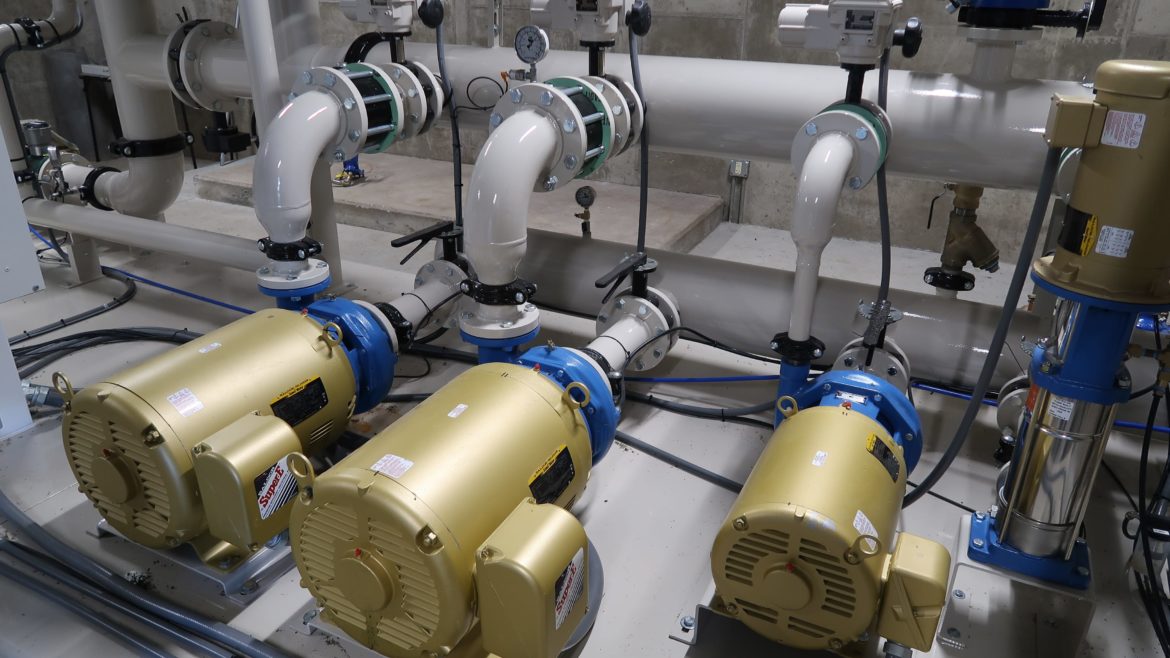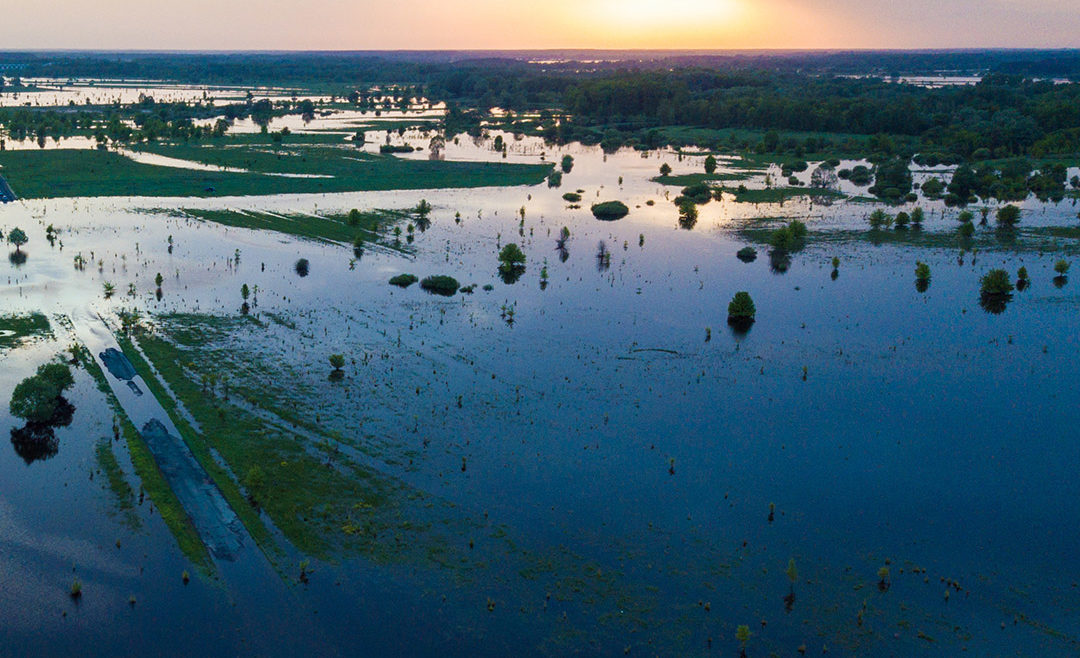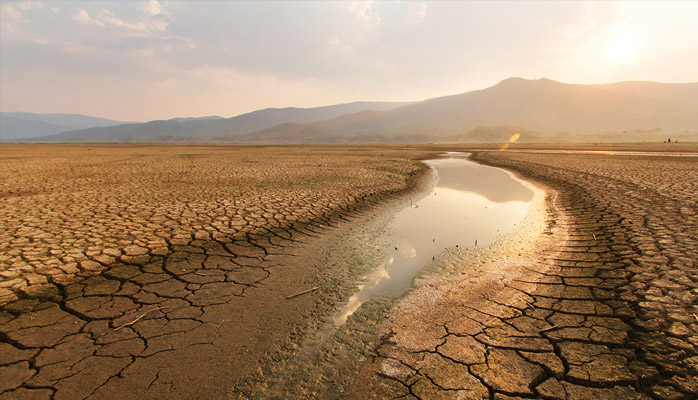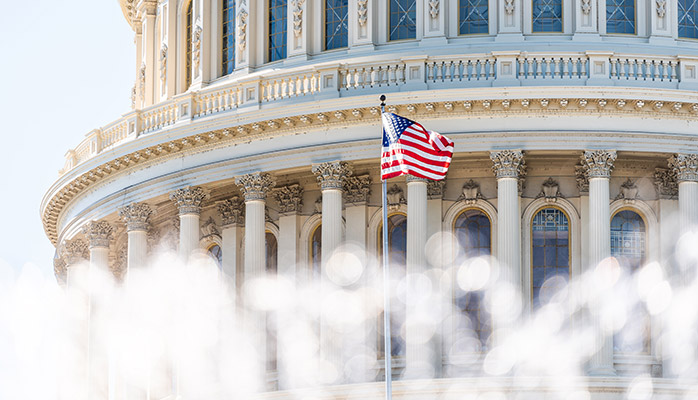
USGA article by our own Derek Nees
Preventative maintenance can prolong the life and efficiency of the pumps. The good news is that pump station failure is usually avoidable – or if not avoidable, at least failure can be forecasted.

Water well maintenance during floods
When a water supply well has been affected by flood waters, the water within the well may be contaminated with bacteria or other microorganisms that can cause serious illness in humans and pets.

Municipal water supply resilience
Tools to achieve municipal water supply resilience
EPA’s Climate Ready Water Utilities Program
As temperatures warm, changes in the water cycle will challenge the reliability of water supplies in some areas. Optimizing the use of supplies from different sources while meeting water-quality standards is crucial to success.
Earth’s oceans and atmosphere are warming. Scientists project that subsequent changes in the water cycle will challenge the reliability of water supplies in some areas. Changes in the amount of precipitation that falls as rain versus snow and earlier spring snowmelt are among the climate-related changes likely to affect the quality and quantity of some water supplies. Non-climate factors such as increased demand from growing populations and aging infrastructure can compound these issues, threatening the ample supply of clean, safe water and reliable wastewater services many Americans take for granted.
To ensure uninterrupted future services, water managers must make infrastructure decisions sooner than later. Decisions to build reservoirs, purchase desalination equipment or increase capacity to manage stormwater or wastewater can take a decade or more to implement plus remain viable for decades into the future.
Climate Resilience Evaluation and Awareness Tool (CREAT) Case Study : Fredericktown, Missouri
https://toolkit.climate.gov/case-studies/addressing-short-and-long-term-risks-water-supply
Resiliency appears to be key to developing a more trustworthy water supply and sanitation system. A 2017 Canadian policy brief highlights best practices:
https://www.iisd.org/library/building-climate-resilient-city-water-supply-and-sanitation-systems
Key message from that brief include:
- Building and maintaining a water supply system resilient to climate shocks requires “multi-barrier” methods that strengthen all infrastructure components.
- Redundancy in water supply should be a policy priority with the flexibility to shift between surface and groundwater options.
- Highly decentralized water supply and sanitation options are now feasible; they provide resilience and complement centralized systems.
- Water conservation and green infrastructure options for stormwater management are proven approaches for reducing climate risks.
The EPS’s Route to Resilience (RtoR) Tool can be of benefit to water managers, too. It uses brief videos and an easy to navigate interface to guide users through the process of building their own unique Roadmap to Resilience report. The RtoR presents five stops to resiliency:
- Assess
- Plan
- Train
- Respond
- Recover
Get started here:
https://www.epa.gov/waterresilience/route-resilience-2018-drinking-water-and-wastewater-utilities
Sources:
Excerpted and adapted from the report Climate Change Impacts in the United States: The Third National Climate Assessment (Chapter 2: Our Changing Climate and Chapter 3: Water Resources) and the Water Resources/Climate Impacts and Adaptation Examples webpage published by the U.S. Environmental Protection Agency.

America’s Water Infrastructure Act
America’s Water Infrastructure Act of 2018 debriefed
America’s Water Infrastructure Act of 2018 (S. 3021, Pub.L. 115–270) is a United States federal law that provides for water infrastructure improvements throughout the country in the areas of:
• flood control
• navigable waterways
• water resources development
• maintenance and repair of dams and reservoirs
• ecosystem restoration
• public water systems (1)
• financing of improvements
• hydropower development
• technical assistance to small communities.
Much of the bill revolves around the Corps of Engineers. The law also reauthorizes the Water Infrastructure Finance and Innovation Act of 2014 (WIFIA) which provides expanded financial assistance to communities under the Clean Water Act and Safe Drinking Water Act.
In terms of Water Resources Infrastructure and Drinking Water System Improvement – excerpts that may affect water managers include:
(Sec. 1401) The bill authorizes specified water resource projects in Arkansas, Puerto Rico, Texas, Washington, California, Hawaii, New York, Florida, and New Mexico. The bill also authorizes project modifications for previously authorized projects in Georgia, Michigan, and Tennessee.
(Sec. 2001) The EPA must implement a program for connecting, expanding, or repairing existing public water systems that are on Indian reservations in the Upper Missouri River Basin or the Upper Rio Grande Basin.
(Sec. 2002) The Safe Drinking Water Act is amended to authorize states to use their drinking water state revolving funds (SRFs) to protect certain source water areas.
(Sec. 2003) The EPA must study and report on intractable water systems (small drinking water systems with a history of significant noncompliance with such Act) and barriers to delivery of potable water to individuals served by such systems.
(Sec. 2005) The EPA may issue grants to assist: (1) underserved communities with contaminated drinking water, and (2) water systems with programs or projects that increase the resilience of drinking water infrastructure to natural hazards.
(Sec. 2006) The EPA must provide grants to: (1) address lead contamination in drinking water at schools and child care programs; and (2) accelerate the development and deployment of innovative water technologies that address pressing drinking water supply, quality, treatment, or security challenges.
(Sec. 2008) The bill expands requirements concerning consumer confidence reports issued by community water systems.
(Sec. 2010) The EPA or a state with primary enforcement authority responsibility under the Act may require the owners or operators of certain public water systems that have repeatedly violated national primary drinking water regulations to consolidate or transfer ownership.
(Sec. 2011) The EPA must develop a strategic plan for improving the accuracy and availability of compliance monitoring data.
(Sec. 2012) Within five years and every five years thereafter, the EPA must review and update educational materials concerning best practices for asset management strategies that may be used by public water systems.
(Sec. 2013) The bill expands risk assessment requirements for community water systems to include risks from natural hazards and creates a grant program within the EPA called the Drinking Water Infrastructure Risk and Resilience Program.
(Sec. 2014) The bill: (1) reauthorizes through FY2021 the public water system supervision grant program and the source water petition program, and (2) reauthorizes through FY2021 and revises the drinking water SRFs.
(Sec. 2017) The EPA must review and report to the public on existing and potential methods, means, equipment, and technologies for the treatment and distribution of drinking water.
(Sec. 2018) The Emergency Planning and Community Right-To-Know Act of 1986 is amended to ensure that states and community water systems are notified of a release of a contaminant into their source waters.
(Sec. 2019) The GAO must study and report on demonstrations of compliance with a state or local environmental law that may be substantially equivalent to demonstrations required by the EPA for compliance with a cross-cutting requirement (i.e., a requirement that is a condition for obtaining loan or loan guarantee under the Safe Drinking Water Act).
(Sec. 2020) The bill authorizes additional grants for SRFs in order to aid certain community water systems that were affected by natural disasters after January 1, 2017.
(Sec. 2021) The bill: (1) expands requirements for public water systems to monitor unregulated containments, and (2) extends through FY2023 a requirement that water system projects financed through a drinking water SRF program only use iron and steel products that are produced in the United States.
(Sec. 2023) The bill reauthorizes through FY2021 and revises the drinking water SRF.
The entire bill can be read here:
https://www.congress.gov/bill/115th-congress/senate-bill/3021/text
(1) The US Safe Drinking Water Act and derivative legislation define “public water system” as an entity that provides “water for human consumption through pipes or other constructed conveyances to at least 15 service connections or serves an average of at least 25 people for at least 60 days a year.”
Over 286 million Americans get their tap water from a community water system. Eight percent of the community water systems—large municipal water systems—provide water to 82 percent of the US population.
Source: United States Government
https://en.wikipedia.org/wiki/America%27s_Water_Infrastructure_Act_of_2018
Source: Wikipedia
https://www.cdc.gov/healthywater/drinking/public/index.html
Source: CDC
https://www.congress.gov/bill/115th-congress/senate-bill/3021
Source: United States Government

Cold Weather Effects on Municipal Water Supplies
Municipal Wells
Although it might not make sense, household water use actually goes up during winter. Think about it, more people spend their time indoors. So when you factor in high-water demands, cold weather challenges for a municipal water supply are magnified.
Most obvious, harsh winters increase risks for elevated tanks, pipes and valves to fail — especially during night when water demand and turnover rate is low. Most temperature-related problems, however, can be prevented with appropriate planning, maintenance and inspections. For example, flowing water is less prone to freezing. Moving water in and out of elevated tanks and mixing systems can lower the risk of failure.
Of particular nuisance for water utilities is frazil ice – a loose collection of slushy ice that forms on cold, clear nights when water temperatures are near freezing. Frazil ice forms at the surface and is notorious for blocking submerged raw water intakes – shutting down pumps. To avoid problems with freezing in the plant and distribution system, sealing external openings and insulating facility buildings, pump and disinfection booster stations can reduce heating loss and cold air penetrations.
For home owners, lateral lines leading from a utility-owned water main through the yard to a home are particularly susceptible to freezing under the roadway or sidewalk where there is no grass or snow to provide an insulating barrier between the cold air and buried pipe.
Winterizing Tips For Water Utilities
Residential Wells
Cold has no apparent negative affect on the equipment nor well, in part, because the well and equipment are sealed on the outside. The well cap and casing serve as insulation in a closed system. Lateral pipes that carry water from your well to a distribution source should be below the frost line. In addition, even during the most severe winter or hottest summer, the ground water held by your well generally stays at approximately 55 degrees year round. Though water levels have been known to drop in winter due to atmospheric pressure – the consistent water temperature keeps most of the equipment in a constant state far from freezing.
Effect of temperature on ground-water levels
As the use of submersible data loggers increases, more and more questions about what to do during the winter months are raised. Should I remove them from the environment? What happens if they freeze? Will they record accurately in the colder temperatures? Can I trust the data recorded at lower temperatures? These answers frequently are … Continue readingCold Weather & Dataloggers
